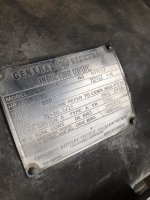As in pounding hot steel from a forge. For knife making?
The 50A circuit/breaker and 50A motor is kind of living on the edge. Your startup current might cause trips.
If 50A is all there is then a soft start has to be done.
breakers that are in Good condition and have not been repeatedly run at very near their capacity
have a relatively long trip time for a medium o/l such as starting a motor, or suddenly loading a motor.
(which this breaker will be in about a year, [therefor i recommend replacing that breaker yearly]
breakers are built to trip due to two kinds of o/l's
1) just under to just over the listed amp rating :: this will cause a bimetallic strip to heat up and cause a trip over time: minutes to hours depending
2) way over the listed amp rating :: this activates a coil that will cause a trip immediately
breakers that have been tripped many times wear out and will do one of two things as a result
1) become harder to trip, and occasionally never trip (a good example is federal types from the US north west areas)
2) become easier to trip, this what most commonly happens to most breakers and brands
the
primary thing you want to consider is the size/AWG and the temperature rating of the
supply wire to the receptacle; especially if it is inside of a closed wall
NEC charts show #8 romex rated for 40A @60*C, and single conductor THHN shows #8 at 55A
if you have #6 romex (NEC = 55A) or single conductors in conduit (75A) your wire will never be a problem
most modern wires whether single conductors or romex cables are made with THHN insulation. it is rated for 90*C which is 194*F, near boiling. this increases the available ampacity of a wire compared to the same size of wire with lesser insulation values
which brings up another point about sizing the breaker to the load and then sizing the wire to the breaker
the NEC ampacity chart i mentioned also assumes that all breakers are rated for 60*C in an ambient of 40*C (ambient matters because of the bimetallic strip) unless stamped otherwise.
many brands of breakers are now stamped 75*C which means they can be sized to the wire at 75* rather than 60* ratings
the result of this is a smaller AWG wire is required for the breaker in some cases
if you really want to know what you have and the capabilities of it. look at 2020 NEC table 310.16




